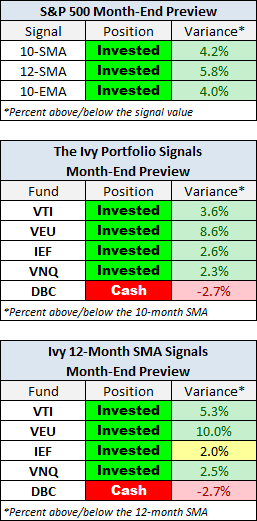Here is an advance preview of the monthly moving averages we track after the close of the last business day of the month. At this point, before the close on the last day of the month, all three S&P 500 strategies are signaling "invested" — unchanged from last month's signal. Four of the five Ivy Portfolio ETFs — Vanguard Total Stock Market ETF (NYSE:VTI), Vanguard FTSE All-World ex-US ETF (NYSE:VEU), iShares Barclays 7-10 Year Treasury (NYSE:IEFA), and Vanguard REIT Index ETF (NYSE:VNQ) — are signaling "invested", unchanged from last month's quadruple "invested" signal.
If a position is less than 2% from a signal, it is highlighted in yellow.
Note: Our inclusion of the S&P 500 index updates is intended to illustrate a popular moving moving-average timing strategy. The index signals also give a general sense of how US equities are behaving. However, for followers of a moving average strategy, the general practice is to make buy/sell decisions on the signals for each specific investment, not based on a broad index. Even if you're investing in a fund that tracks the S&P 500 (e.g., Vanguard's VFINX or the SPDR S&P 500 (NYSE:SPY) ETF) the moving average signals for the funds will occasionally differ from the underlying index because of dividend reinvestment, which is not factored into the index closes.
The Ivy Portfolio
The second of the three adjacent tables previews the 10-month SMA timing signals for the five asset classes highlighted in The Ivy Portfolio.
We've also included (third table) the 12-month SMA timing signals for the Ivy ETFs in response to the many requests to include this slightly longer time frame.
After the end-of-month market close, we'll update the monthly moving average feature with charts to illustrate.
The bottom line is that these moving-average signals have a good track record for long-term gains while avoiding major losses. They're not fool-proof, but they essentially dodged the 2007-2009 bear and have captured significant gains since the initial buy signals after the March 2009 low.

